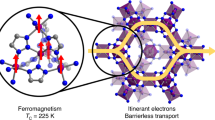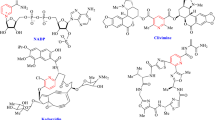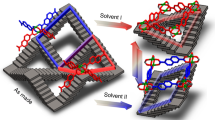Abstract
With adequate building blocks, metal–organic frameworks (MOFs) can combine magnetic ordering and porosity. This makes MOFs a promising platform for the development of stimuli-responsive materials that show drastically different magnetic properties depending on the presence or absence of guest molecules within their pores. Here we report a CO2-responsive magnetic MOF that converts from ferrimagnetic to paramagnetic on CO2 adsorption, and returns to the ferrimagnetic state on CO2 desorption. The ferrimagnetic material is a layered MOF with a [D+–A−–D] formula, produced from the reaction of trifluorobenzoate-bridged paddlewheel-type diruthenium(ii) clusters as the electron donor (D) with diethoxytetracyanoquinodimethane as the electron acceptor (A). On CO2 uptake, it undergoes an in-plane electron transfer and a structural transition to adopt a [D–A–D] paramagnetic form. This magnetic phase change, and the accompanying modifications to the electronic conductivity and permittivity of the MOF, are electronically stabilized by the guest CO2 molecules accommodated in the framework.

This is a preview of subscription content, access via your institution
Access options
Access Nature and 54 other Nature Portfolio journals
Get Nature+, our best-value online-access subscription
$29.99 / 30 days
cancel any time
Subscribe to this journal
Receive 12 print issues and online access
$259.00 per year
only $21.58 per issue
Buy this article
- Purchase on Springer Link
- Instant access to full article PDF
Prices may be subject to local taxes which are calculated during checkout






Similar content being viewed by others
Data availability
The data that support this work are available in the article and its Supplementary Information files. Further raw data are available from the corresponding authors upon reasonable request. X-ray crystallographic data have been deposited as CIFs at the Cambridge Crystallographic Data Centre (http://www.ccdc.cam.ac.uk/) with CCDC numbers 1914693 (1-DCM), 1914694 (1), 1914695 (1⊃CO2-I) and 1914696 (1⊃CO2-II). A copy of the data can be obtained free of charge via https://www.ccdc.cam.ac.uk/structures/. Source data are provided with this paper.
References
Kurmoo, M. Magnetic metal–organic frameworks. Chem. Soc. Rev. 38, 1353–1379 (2009).
Dechambenoit, P. & Long, J. R. Microporous magnets. Chem. Soc. Rev. 40, 3249–3265 (2011).
Coronado, E. & Espallargas, G. M. Dynamic magnetic MOFs. Chem. Soc. Rev. 42, 1525–1539 (2013).
Espallargas, G. M. & Coronado, E. Magnetic functionalities in MOFs: from the framework to the pore. Chem. Soc. Rev. 47, 533–557 (2018).
Miller, J. S. Magnetically ordered molecule-based materials. Chem. Soc. Rev. 40, 3266–3296 (2011).
Ohkoshi, S. et al. Photoinduced magnetization in copper octacyanomolybdate. J. Am. Chem. Soc. 128, 270–277 (2006).
Brataas, A., Kent, A. D. & Ohno, H. Current-induced torques in magnetic materials. Nat. Mater. 11, 372–381 (2012).
Lottermoser, T. et al. Magnetic phase control by an electric field. Nature 430, 541–544 (2004).
Ohkoshi, S., Arai, K., Sato, Y. & Hashimoto, K. Humidity-induced magnetization and magnetic pole inversion in a cyano-bridged metal assembly. Nat. Mater. 3, 857–861 (2004).
Kurmoo, M., Kumagai, H., Chapman, K. W. & Kepert, C. J. Reversible ferromagnetic–antiferromagnetic transformation upon dehydration–hydration of the nanoporous coordination framework, [Co3(OH)2(C4O4)2]·3H2O. Chem. Commun. 24, 3012–3014 (2005).
Kaneko, W., Ohba, M. & Kitagawa, S. A flexible coordination polymer crystal providing reversible structural and magnetic conversions. J. Am. Chem. Soc. 129, 13706–13712 (2007).
Yoshida, Y., Inoue, K., Kikuchi, K. & Kurmoo, M. Biomimetic transformation by a crystal of a chiral Mnii−Criii ferrimagnetic Prussian blue analogue. Chem. Mater. 28, 7029–7038 (2016).
Wang, Z.-M., Zhang, Y.-J., Liu, T., Kurmoo, M. & Gao, S. [Fe3(HCOO)6]: a permanent porous diamond framework displaying H2/N2 adsorption, guest inclusion, and guest-dependent magnetism. Adv. Funct. Mater. 17, 1523–1536 (2007).
Zeng, M.-H. et al. Nanoporous cobalt(ii) MOF exhibiting four magnetic ground states and changes in gas sorption upon post-synthetic modification. J. Am. Chem. Soc. 136, 4680–4688 (2014).
Zhang, J., Kosaka, W., Sugimoto, K. & Miyasaka, H. Magnetic sponge behavior via electronic state modulations. J. Am. Chem. Soc. 140, 5644–5652 (2018).
Navarro, J. A. R. et al. Guest-induced modification of a magnetically active ultramicroporous, gismondine-like, copper(ii) coordination network. J. Am. Chem. Soc. 130, 3978–3984 (2008).
Kaye, S. S., Choi, H. J. & Long, J. R. Generation and O2 adsorption studies of the microporous magnets CsNi[Cr(CN)6] (TC = 75 K) and Cr3[Cr(CN)6]2·6H2O (TN = 219 K). J. Am. Chem. Soc. 130, 16921–16925 (2008).
Bloch, E. D. et al. Hydrocarbon separations in a metal–organic framework with open iron(ii) coordination sites. Science 335, 1606–1610 (2012).
Coronado, E., Gimenez-Marques, M., Espallargas, G. M. & Brammer, L. Tuning the magneto-structural properties of non-porous coordination polymers by HCl chemisorption. Nat. Commun. 3, 828 (2012).
Kosaka, W. et al. Gas-responsive porous magnet distinguishes the electron spin of molecular oxygen. Nat. Commun. 9, 5420 (2018).
Murphy, M. J. et al. Guest programmable multistep spin crossover in a porous 2‑D Hofmann-type material. J. Am. Chem. Soc. 139, 1330–1335 (2017).
Halder, G. J., Kepert, C. J., Moubaraki, B., Murray, K. S. & Cashion, J. D. Guest-dependent spin crossover in a nanoporous molecular framework material. Science 298, 1762–1765 (2002).
Neville, S. M. et al. Guest tunable structure and spin crossover properties in a nanoporous coordination framework material. J. Am. Chem. Soc. 131, 12106–12108 (2009).
Coronado, E., Gimenez-Marques, M., Espallargas, G. M., Rey, F. & Vitorica-Yrezabal, I. J. Spin-crossover modification through selective CO2 sorption. J. Am. Chem. Soc. 135, 15986–15989 (2013).
Zhou, H. C., Long, J. R. & Yaghi, O. M. Introduction to metal–organic frameworks. Chem. Rev. 112, 673–674 (2012).
Kitagawa, S., Kitaura, R. & Noro, S. Functional porous coordination polymers. Angew. Chem. Int. Ed. 43, 2334–2375 (2004).
Chu, S. Carbon capture and sequestration. Science 325, 1599 (2009).
Boot-Handford, M. E. et al. Carbon capture and storage update. Energy Environ. Sci. 7, 130–189 (2014).
Liao, P. Q., Huang, N. Y., Zhang, W. X., Zhang, J. P. & Chen, X. M. Controlling guest conformation for efficient purification of butadiene. Science 356, 1193–1196 (2017).
Kong, X. et al. Mapping of functional groups in metal–organic frameworks. Science 341, 882–885 (2013).
Farha, O. K. & Hupp, J. T. Rational design, synthesis, purification, and activation of metal−organic framework materials. Acc. Chem. Res. 43, 1166–1175 (2010).
McDonald, T. M. et al. Cooperative insertion of CO2 in diamine-appended metal–organic frameworks. Nature 519, 303–308 (2015).
Sumida, K. et al. Carbon dioxide capture in metal–organic frameworks. Chem. Rev. 112, 724–781 (2012).
Thallapally, P. K. et al. Flexible (breathing) interpenetrated metal−organic frameworks for CO2 separation applications. J. Am. Chem. Soc. 130, 16842–16843 (2008).
Carrington, E. J. et al. Solvent-switchable continuous-breathing behaviour in a diamondoid metal–organic framework and its influence on CO2 versus CH4 selectivity. Nat. Chem. 9, 882–889 (2017).
Diercks, C. S., Liu, Y., Cordova, K. E. & Yaghi, O. M. The role of reticular chemistry in the design of CO2 reduction catalysts. Nat. Mater. 17, 301–307 (2018).
Niu, K. et al. A spongy nickel–organic CO2 reduction photocatalyst for nearly 100% selective CO production. Sci. Adv. 3, 1700921 (2017).
Miyasaka, H. Control of charge transfer in donor/acceptor metal–organic frameworks. Acc. Chem. Res. 46, 248–257 (2013).
Miyasaka, H. in Materials and Energy (eds Vardeny, Z. V. & Wohlgenannt, M.) Ch. 4, 169−205 (World Scientific, 2018).
Uemura, K., Kitagawa, S., Fukui, K. & Saito, K. A contrivance for a dynamic porous framework: cooperative guest adsorption based on square grids connected by amide−amide hydrogen bonds. J. Am. Chem. Soc. 126, 3817–3828 (2004).
Kosaka, W. et al. Magnetic sponge with neutral–ionic phase transitions. Adv. Sci. 5, 1700526 (2018). (1−10).
Cotton, F. A. & Walton, R. A. Multiple Bonds Between Metal Atoms 2nd edn (Oxford Univ. Press, 1993).
Miyasaka, H. et al. Tuning of the ionization potential of paddlewheel diruthenium(ii,ii) complexes with fluorine atoms on the benzoate ligands. Dalton Trans. 40, 673–682 (2011).
Kosaka, W., Itoh, M. & Miyasaka, H. The effect of chlorine and fluorine substitutions on tuning the ionization potential of benzoate-bridged paddlewheel diruthenium(ii, ii) complexes. Dalton Trans. 44, 8156–8168 (2015).
Kosaka, W., Yamagishi, K., Zhang, J. & Miyasaka, H. Gate-opening gas adsorption and host–guest interacting gas trapping behavior of porous coordination polymers under applied a.c. electric fields. J. Am. Chem. Soc. 136, 12304–12313 (2014).
Hirshfeld, F. L. Bonded-atom fragments for describing molecular charge densities. Theoret. Chim. Acta 44, 129–138 (1977).
Yanai, N. et al. Gas detection by structural variations of fluorescent guest molecules in a flexible porous coordination polymer. Nat. Mater. 10, 787–793 (2011).
Kreno, L. E. et al. Metal–organic framework materials as chemical sensors. Chem. Rev. 112, 1105–1125 (2012).
Miyasaka, H. et al. Tuning of the ionization potential of paddlewheel diruthenium (ii, ii) complexes with fluorine atoms on the benzoate ligands. Dalton Trans. 40, 673–682 (2011).
Boudreaux, E. A. & Mulay, L. N. Theory and Application of Molecular Paramagnetism (John Wiley & Sons, 1976).
Sheldrick, G. M. SHELXT: integrating space group determination and structure solution. Acta Crystallogr. A 70, C1437 (2014).
Momma, K. & Izumi, F. VESTA 3 for three-dimensional visualization of crystal, volumetric and morphology data. J. Appl. Cryst. 44, 1272–1276 (2011).
Spek, A. L. Single-crystal structure validation with the program PLATON. J. Appl. Cryst. 36, 7–13 (2003).
Kitagawa, Y. et al. Theoretical studies on effects of hydrogen bonds attaching to cysteine ligands on 4Fe–4S clusters. Int. J. Quant. Chem. 108, 2881–2887 (2008).
Roy, L. E., Hay, P. J. & Martin, R. L. Revised basis sets for the LANL effective core potentials. J. Chem. Theory Comput. 4, 1029–1031 (2008).
Fukutome, H. The unrestricted Hartree–Fock theory of chemical reactions. I: The electronic instabilities in the chemical reactions and the solutions of the unrestricted SCF LCAO MO equation for the homopolar two-center two-electron system. Prog. Theoret. Phys 47, 1156–1180 (1972).
Szabo, A. & Ostlund, N. S. Modern Quantum Chemistry: Introduction to Advanced Electronic Structure Theory (Dover, 1996).
Frisch, M. J. et al. Gaussian 09 Revision C.01 (Gaussian, Inc., 2009).
Acknowledgements
We thank H. Sato for his assistance with the single-crystal X-ray crystallography of the CO2-accommodated compounds. This work was supported by a Grant‐in‐Aid for Scientific Research (nos 16H02269, 18K19050, 18K05055, 18H05208, 19K05401, 20K15294 and 20H00381) from MEXT, Japan, and on Innovative Areas (‘π‐System Figuration’ Area 2601, no. 17H05137) from JSPS, Japan, the GIMRT programme, the E‐IMR project and a Grant Fund for Research and Education (no. J190001232). J.Z. is thankful for the JSPS KAKENHI (No. 17J02497).
Author information
Authors and Affiliations
Contributions
J.Z. and H.M. formulated the project. J.Z. performed the experiments. W.K. established the experimental set-ups, especially the measurements with the gases, and supported the experiments. Y.K. performed the theoretical calculations. All the authors contributed to the writing of the manuscript.
Corresponding author
Ethics declarations
Competing interests
The authors declare no competing interests.
Additional information
Publisher’s note Springer Nature remains neutral with regard to jurisdictional claims in published maps and institutional affiliations.
Supplementary information
Supplementary Information
Supplementary Figs. 1–43, discussion and Tables 1–8 (except Table 6 as separate file).
Supplementary Table 6
Atomic coordinates for Models A–D.
Supplementary Data
Cif for 1-DCM
Supplementary Data
Cif for 1
Supplementary Data
Cif for 1-CO2-I
Supplementary Data
Cif for 1-CO2-II
Source data
Source Data Fig. 1
Source data for Fig. 1f,1g.
Source Data Fig. 2
Source data for Fig. 2a–f.
Source Data Fig. 4
Source data for Fig. 4a–g.
Source Data Fig. 5
Source data for Fig. 5a–c.
Rights and permissions
About this article
Cite this article
Zhang, J., Kosaka, W., Kitagawa, Y. et al. A metal–organic framework that exhibits CO2-induced transitions between paramagnetism and ferrimagnetism. Nat. Chem. 13, 191–199 (2021). https://doi.org/10.1038/s41557-020-00577-y
Received:
Accepted:
Published:
Issue Date:
DOI: https://doi.org/10.1038/s41557-020-00577-y
This article is cited by
-
Light-driven anisotropy of 2D metal-organic framework single crystal for repeatable optical modulation
Communications Materials (2024)
-
Self-recovering passive cooling utilizing endothermic reaction of NH4NO3/H2O driven by water sorption for photovoltaic cell
Nature Communications (2023)
-
A spin-crossover framework endowed with pore-adjustable behavior by slow structural dynamics
Nature Communications (2022)
-
Giant single-crystal-to-single-crystal transformations associated with chiral interconversion induced by elimination of chelating ligands
Nature Communications (2021)



